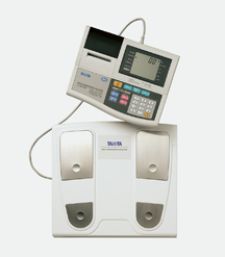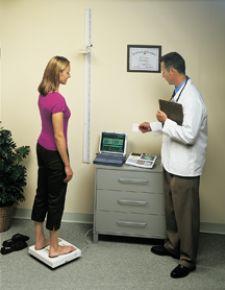
Bio-electrical impedance analysis enables accuracy.
Everyone needs a certain amount of body fat to stay healthy. Too little or too much can cause serious health problems. But most patients who put
themselves on a diet are seldom aware that part of their weight loss could signal a loss of muscle tissue rather than body fat.
By being able to accurately measure the percentage of body fat in a patient, the clinician can design an appropriate diet and exercise program that leads to the desired results, says Alan Pressman, Ph.D., a New York State certified nutritionist and dietitian whose practice, Gramercy Health Associates, is located in New York City. “It doesn’t matter what you weigh,” he explained. “It matters what your weight is composed of: How much fat is in your body. How much water is in your body. We want to see a consistent decrease in fat.”
For the past eight years Dr. Pressman has been monitoring his patients’ body fat with the Tanita TBF-300A Body Composition Analyzer/Scale.
In the past, Dr. Pressman relied on hand-held calipers to gauge a patient’s skinfold thickness. But results were often inconsistent. After purchasing the TBF-300A, he discovered that all of his measurements were not only consistent, but that he was measuring exactly what he had observed in his patients. Plus, the device allowed his patients to better understand their own body composition so that they were not as concerned about losing weight as they were about losing body fat. “It’s a great tool to show progress or lack of progress,” he said. “Now we can regulate how much they’re eating and how much they’re exercising.”
The accuracy of the TBF-300A is largely due to its method of measurement which is bio-electrical impedance analysis (BIA). Unlike skinfold measurements or underwater weighing, BIA uses a small electrical current (50kHz, 500Ma) that passes through the body and is carried by water and fluids. Since impedance is greater in fat tissue, which contains only 10-20 percent water — as compared to fat-free mass, which contains 70-75 percent water — it’s easy to calculate the percentage of body fat, fat-free mass and hydration levels.
The system uses two footpad electrodes that are incorporated within the platform of an electronic scale. Built-in software then uses the measured impedance as well as the patient’s gender, height, weight, age and fitness level to calculate the body fat percentage.
Although conventional BIA uses underwater weighing as its standard of reference, the Tanita BIA uses dual energy X-ray absorptiometry (DEXA), which, because it uses a whole body scan, is quickly becoming the new gold standard.
Results from the TBF-300A can be obtained within 30 seconds and are digitally displayed on a small monitor. The built-in printer also allows the clinician to share the information with the patient and to facilitate the design
of an appropriate diet/exercise program based on that patient’s desirable range and target body fat.
As a portable unit, the TBF-300A weighs only 17.5 pounds, but has a maximum capacity of 440 pounds.
While the TBF-300A costs around $2,000, Dr. Pressman said, “It paid for itself in a month.”


